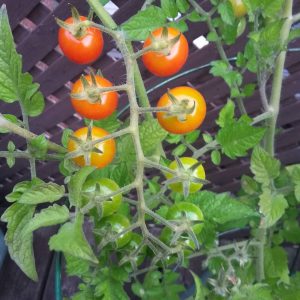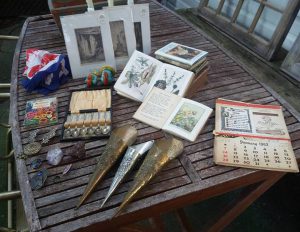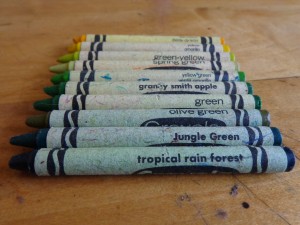Treasure
On some mornings, especially mornings like this one, the ache to speak with my mother becomes a physical thing.
 The cool air, the golden light, a faint crackle in the leaves: all portents of a shift in the season. The ripe tomatoes I picked and ate this morning, fresh from the vine, ripe and earthy and pulsating with light.
The cool air, the golden light, a faint crackle in the leaves: all portents of a shift in the season. The ripe tomatoes I picked and ate this morning, fresh from the vine, ripe and earthy and pulsating with light.
A garage sale around the corner at which for a few dollars I bought a pile of beautiful old books, a handful of old jewelry, a set of silver plate Apostle spoons, a vintage maple leaf scarf, a salt-and-pepper set made in Occupied Japan, two chunks of amethyst, and two mid-century calendars stuffed with kitchen advice and recipes.
Everything else that has happened in the five months since she died.
*
Twenty years ago, early every summer Saturday morning my mother and I would peel off in the car, either with my father or a next-door neighbour, to troll garage sales looking for treasure. The perfect yard sale morning, to both of us, would yield some interesting books, some ‘breakables’ (china, kitchenware, collectables), tools, some item of furniture, a little bit of jewelry, and at least one piece of art. Clothing, a carpet, a lamp, some useful household object or appliance, would be a bonus. On a perfect morning we came home with the car stuffed full. More than a few times another beloved neighbour brought home excess in his pick-up truck.
Many of the objects she bought were distributed to those who needed or wanted them, or were tucked away to be given as birthday or Christmas presents. The treasures, however, ended up in her cupboards and china cabinets or were hung on the wall.
And there they sat for two decades, admired but largely unused, their glitter growing dimmer, until after her death.
After her death I cleaned out her house and prepared it for sale. I packed all her clothes and arranged for their donation. I sorted her make-up and panty hose and medications and toiletries. I held an estate sale and sold her breakables and art. I packed her papers and brought them to my home, alongside all the things I could not bear to leave behind. As promised, I bore the burden of her death and, in doing so, came to realize that I would also bear the burden of her life.
*
In the five months since my mother died I have spent whole days in our garage, sorting and filing, or shredding as required, the paper detritus of her life. Financial records dating to the late 1960s. Letters, bills, research projects, consultant reports, manuscripts, publishing contracts, her peripatetic private journal. In doing so I have given a great deal of thought to the project of giving posthumous shape to her life.
A life is, of course, a narrative. It is a story we tell ourselves even before we transact it with others. But what becomes of that story when we die?
Often enough the story dies, too, memory being what it is.
*
I am not a person who forgets, which is not the only reason my mother asked me to be her literary executor. She also asked because I knew who she was.
This knowing is not precisely a source of comfort. It is actually, in some ways, a source of considerable anguish.
It is a source of anguish because I knew about her desires and, more particularly, her regrets. I knew how she served, and I knew what she gave up in order to do so.
I knew all this because my mother and I were, are, very much alike.
Our kindredness was not always a source of solace, but it was always there, the undercurrent to our discussions about writing, our perspectives on politics and people, even our garage sale going.
And this is why, especially on mornings like this one, the ache to speak with her becomes a physical thing.
 Because she too would sense the currents in the air, the shifting of the seasons. She too would gloat over a pile of garage sale treasures: the musty, leathery smell of old books; the slippery feel of tarnished metal and its promise of restoration. And she too would feel the compulsion to write about it all, to capture some trace of these ephemeral moments: the golden light, the drift of wind through the leaves, the taste of ripe tomatoes, incandescent with sunlight and warm from the vine. And the task of giving shape to memory, of holding together the pieces of the story.
Because she too would sense the currents in the air, the shifting of the seasons. She too would gloat over a pile of garage sale treasures: the musty, leathery smell of old books; the slippery feel of tarnished metal and its promise of restoration. And she too would feel the compulsion to write about it all, to capture some trace of these ephemeral moments: the golden light, the drift of wind through the leaves, the taste of ripe tomatoes, incandescent with sunlight and warm from the vine. And the task of giving shape to memory, of holding together the pieces of the story.
